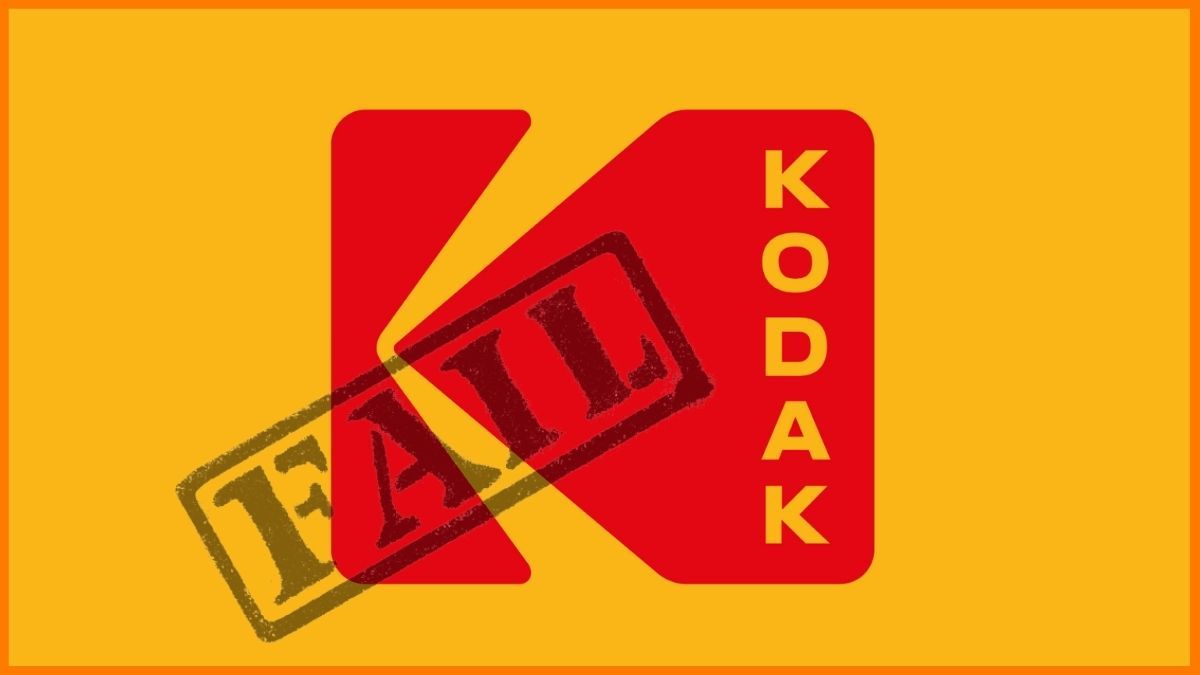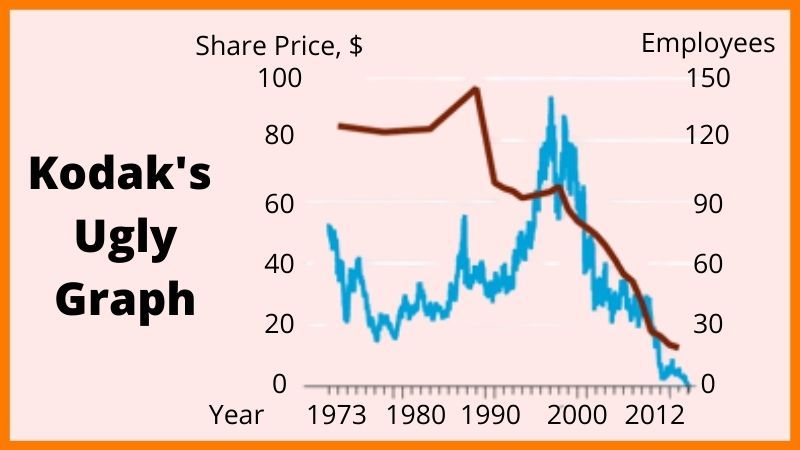Why Did Kodak Fail? | Kodak Bankruptcy Case Study
🔍Insights
Kodak, as we know it today, was founded in the year 1888 by George Eastman as ‘The Eastman Kodak Company’. It was the most famous name in the world of photography and videography in the 20th century. Kodak brought about a revolution in the photography and videography industries. At the time when only huge companies could access the cameras used for recording movies, Kodak enabled the availability of cameras to every household by producing equipment that was portable and affordable.
Kodak was the most dominant company in its field for almost the entire 20th century, but a series of wrong decisions killed its success. The company declared itself bankrupt in 2012. Why did Kodak, the king of photography and videography, go bankrupt? What was the reason behind Kodak's failure? Why did Kodak fail despite being the biggest name of its time? This case study answers the same.
Why Did Kodak Fail?
Biggest Reason Of Kodak's Failure - Fights against Fuji Films
Kodak's Bankruptcy Protection
Ressurection of Kodak: Kodak in the mobile industry?
Why Did Kodak Fail?

Kodak, for many years, enjoyed unmatched success all over the world. By 1968, it had captured about 80% of the global market share in the field of photography.
Kodak adopted the 'razor and blades' business plan. The idea behind the razor-blade business plan is to first sell the razors with a small margin of profit. After buying the razor, the customers will have to purchase the consumables (the razor blades in this case) again and again; hence, sell the blades at a high-profit margin. Kodak's plan was to sell cameras at affordable prices with only a small margin for profit and then sell the consumables such as films, printing sheets, and other accessories at a high-profit margin.
Using this business model, Kodak was able to generate massive revenues and turned into a money-making machine.
As technology progressed, the use of films and printing sheets gradually came to a halt. This was due to the invention of digital cameras in 1975. However, Kodak dismissed the capabilities of the digital camera and refused to do something about it. Did you know that the inventor of the digital camera, Steven Sasson, was an electrical engineer at Kodak when he developed the technology? When Steven told the bosses at Kodak about his invention, their response was, “That’s cute, but don’t tell anyone about it. That's how you shoot yourself in the foot!"

Kodak ignored digital cameras because the business of films and paper was very profitable at that time and if these items were no longer required for photography, Kodak would be subjected to huge losses and end up closing down the factories which manufactured these items.
The idea was then implemented on a large scale by a Japanese company by the name of ‘Fuji Films’. And soon enough, many other companies started the production and sales of digital cameras, leaving Kodak way behind in the race.
This was Kodak's first mistake. The ignorance of new technology and not adapting to the changing market dynamics initiated Kodak's downfall.


List of Courses Curated By Top Marketing Professionals in the Industry
These are the courses curated by Top Marketing Professionals in the Industry who have spent 100+ Hours reviewing the Courses available in the market. These courses will help you to get a job or upgrade your skills.
Biggest Cause Of Kodak's Failure
After the digital camera became popular, Kodak spent almost 10 years arguing with Fuji Films, its biggest competitor, that the process of viewing an image captured by the digital camera was a typical process and people loved the touch and feel of a printed image. Kodak believed that the citizens of the United States of America would always choose it over Fuji Films, a foreign company.
Fuji Films and many other companies focused on gaining a foothold in the photography & videography segment rather than engaging in a verbal spat with Kodak. And once again, Kodak wasted time promoting the use of film cameras instead of emulating its competitors. It completely ignored the feedback from the media and the market. Kodak tried to convince people that film cameras were better than digital cameras and lost 10 valuable years in the process.
Kodak also lost the external funding it had during that time. People also realized that digital photography was way ahead of traditional film photography. It was cheaper than film photography and the image quality was better.
Around that time, a magazine stated that Kodak was being left behind because it was turning a blind spot to new technology. The marketing team at Kodak tried to convince the managers about the change needed in the company's core principles to achieve success. But Kodak's management committee continued to stick with its outdated idea of relying on film cameras and claimed the reporter who said the statement in the magazine did not have the knowledge to back his proposition.
Kodak failed to realize that its strategy which was effective at one point was now depriving it of success. Rapidly changing technology and market needs negated the strategy. Kodak invested its funds in acquiring many small companies, depleting the money it could have used to promote the sales of digital cameras.
When Kodak finally understood and started the sales and the production of digital cameras, it was too late. Many big companies had already established themselves in the market by then and Kodak couldn't keep pace with the big shots.
In the year 2004, Kodak finally announced it would stop the sales of traditional film cameras. This decision made around 15,000 employees (about one-fifth of the company’s workforce at that time) redundant. Before the start of the year 2011, Kodak lost its place on the S&P 500 index which lists the 500 largest companies in the United States on the basis of stock performance. In September 2011, the stock prices of Kodak hit an all-time low of $0.54 per share. The shares lost more than 50% of their value throughout that year.


Kodak's Bankruptcy Protection
By January 2012, Kodak had used up all of its resources and cash reserves. On the 19th of January in 2012, Kodak filed for Chapter 11 bankruptcy protection which resulted in the reorganization of the company. Kodak was provided with $950 million on an 18-month credit facility by the CITI group.
The credit enabled Kodak to continue functioning. To generate more revenue, some sections of Kodak were sold to other companies. Along with this, Kodak decided to stop the production and sales of digital cameras and stepped out of the world of digital photography. It shifted to the sale of camera accessories and the printing of photos.
Kodak had to sell many of its patents, including its digital imaging patents, which amounted to more than $500 million in bankruptcy protection. In September 2013, Kodak announced it had emerged from Chapter 11 bankruptcy protection.
Ressurection of Kodak: Kodak in the mobile industry?
Celebrated camera accessory manufacturers of yesteryear, Kodak, is looking to join Chinese smartphone manufacturing giant Oppo for an upcoming flagship smartphone. This new smartphone is rumored to have 50MP dual cameras, where the cameras of the device will be modeled upon the old classic camera designs of the Kodak models.
The all-new flagship model of Oppo is designed to be a tribute to the classic Kodak camera design. The camera of this Oppo model will allegedly use the Sony IMX766 50MP sensor. Furthermore, the phone will also embed a large sensor in its ultrawide camera as well along with a 13MP telephoto lens and a 3MP microscope camera.
No other information on this matter is currently available as of September 13, 2021.
The collaborations between Android OEMs and camera makers are not something new. Yes, numerous other companies have already come together with other camera manufacturing companies like Nokia, which joined hands with German optics company Carl Zeiss earlier in 2007 to bring in the camera phone Nokia N95. This can be concluded as the first of such collaborations that the smartphone industry has seen. Numerous other collaborations happened eventually, which resulted in outstanding results. OnePlus' partnership with Hasselblad, Huawei pairing up with Leica and the recent news of Samsung's associating with Olympus are some of the significant collaborations to be mentioned.
Kodak had earlier made a leap into the smart TV industry and is ushering in success through this new move. Kodak TV India has already commissioned a plant in Hapur, Uttar Pradesh in August 2020, designed to manufacture affordable Android smart TVs for India. Furthermore, the renowned photography company is looking to invest more than Rs 500 crores during the next 3 years for making a fully automated TV manufacturing plant possible in Hapur. The company committed to this plan as part of its ‘Make in India’ initiative and will leverage its Android certification. Kodak's announcement, as it seemed, was further recharged with the Aatmanirbhar Bharat campaign launched by PM Narendra Modi in the wake of the coronavirus pandemic in 2020.
The TV industry of India imports most of its raw materials and exhibits a value addition of only about 10-12%. However, with the investment that Kodak has promised the company has aimed to increase the value-added to around 50-60%. The Hapur R&D facility will foster the manufacturing of technology-driven products and introduce numerous other lines of manufacturing aligned with the "Make in India" belief.
Super Plastronics Pvt Ltd, a Noida-based company has obtained the license from Kodak Smart TVs to produce and sell their products in India in partnership with the New-York based company and has already launched a range of smart TVs already, as of September 2021 including:
- Kodak 40FHDX7XPRO 40-inch Full HD Smart LED TV
- Kodak 43FHDX7XPRO 43-inch Full HD Smart LED TV
- Kodak 42FHDX7XPRO 42-inch Full HD Smart LED TV
- Kodak 32HDXSMART 32-inch HD ready Smart LED TV
and more. Besides, Kodak HD LED TVs were also up for sale at the lowest prices for 2020, in partnership with Flipkart and Amazon for The Big Billion Days Sale and the Great Indian Sale respectively. This sale, which took place between 16th and 21st October 2020, also included the all-new Android 7XPRO series, which starts at Rs 10999 only and is currently dubbed as the most affordable android tv in India.


Want to Work in Top Gobal & Indian Startups or Looking For Remote/Web3 Jobs - Join angel.co
Angel.co is the best Job Searching Platform to find a Job in Your Preferred domain like tech, marketing, HR etc.
FAQs
What happened to Kodak?
Kodak was ousted from the market of camera and photography due to numerous missteps. Here are some insights into the same:
- The ignorance of new technology and not adapting to changing market needs initiated Kodak's downfall
- Kodak invested its funds in acquiring many small companies, depleting the money it could have used to promote the sales of digital cameras.
- Kodak wasted time promoting the use of film cameras instead of emulating its competitors. It completely ignored the feedback from the media and the market
- When Kodak finally understood and started the sales and the production of digital cameras, it was too late. Many big companies had already established themselves in the market by then and Kodak couldn't keep pace with the big shots
- In September 2011, the stock prices of Kodak hit an all-time low of $0.54 per share
- Kodak declared bankruptcy in 2012
Why did Kodak fail and what can you learn from its demise?
Kodak failed to understand that its strategy of banking on traditional film cameras (which was effective at one point) was now depriving the company of success. Rapidly changing technology and evolving market needs made the strategy obsolete.
Is Kodak still in Business?
Kodak declared itself bankrupt in 2012. Kodak's bankruptcy resulted in the formation of the Kodak Alaris company, a British organization that part-owns the Kodak brand along with the American Eastman Kodak Company.
When did Kodak go out of business?
Kodak faced its demise in 2012.
Is Kodak a good camera?
Kodak's cameras and accessories were of premium quality and the first of the choices professional photographers and others. The company was a winner in the analogue era of photography. However, the company dived down to hit the rock-bottom level.
What does Kodak do now?
Currently, Kodak provides packaging, functional printing, graphic communications, and professional services for businesses around the world. Better known for making cameras, Kodak moved into drug making and has secured a $765m (£592m) loan from the US government in 2020.
Why was Kodak so successful?
Kodak adopted the 'razor and blades' business plan. The idea here was to first sell the razors with a small margin of profit. After buying the razor, the customers will have to purchase the consumables (the razor blades in this case) again and again; hence, sell the blades at a high-profit margin. Kodak's plan was to sell cameras at affordable prices with only a small margin for profit and then sell the consumables such as films, printing sheets, and other accessories at a high-profit margin.







